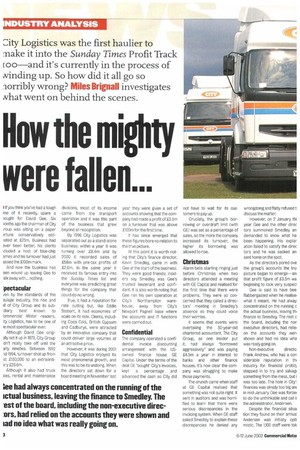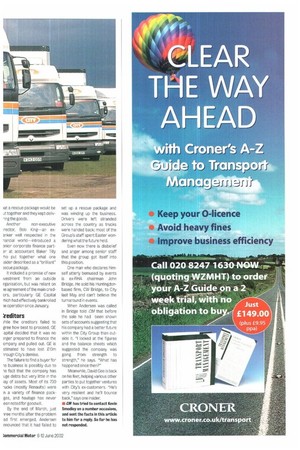How the mighty were fallen...
Page 10

Page 11

If you've noticed an error in this article please click here to report it so we can fix it.
I If you think you've had a tough me of it recently, spare a iought for Davld Gee. Six lonths ago the chairman of City roup was sitting on a paper artune conservatively estiiated at 225m. Business had ever been better, his clients Ieluded a host of blue-chip ries and his turnover had just assed the 2100m mark.
And now the business has een wound up leaving Gee to elk away with... nothing.
:pectacular
ven by the standards of the aulage industry, the rise and II of City Group and its sub
diary hest known to 'ommercial Motor readers, ity Logistics, has to be one of le most spectacular ever.
Although David Gee origially set it up in 1979, City Group dn't really take off until the any nineties. Between 1992 -id 1994, turnover shot up from st 2130,000 to an extraordiary 223.6m.
Although it also had track lies, rental and maintenance divisions, most of its income came from the transport operation and it was this part of the business that grew beyond all recognition.
By 1996 City Logistics was separated out as a stand-alone business: within a year it was turning over .28.4m and by 2000 it recorded sales of 258m with pre-tax profits of 22.6m. In the same year it received its famous entry into the Sunday Times list and everyone was predicting great things for the company that could do no wrong.
True, it had a reputation for rate cutting but, like Eddie Stobart, it had economies of scale on its side. Clients, including Coca Cola, British Gypsum and Cadburys, were attracted by an innovative company that could deliver large volumes at an attractive price.
However, it was during 2001 that City Logistics enjoyed its most phenomenal growth, and this was to be its undoing. When the directors sat down for a board meeting in November last year they were given a set of accounts showing that the company had made a profit of 23.5m on a turnover that was above 2100m for the first time.
It has since emerged that these figures bore no relation to the true picture.
At this point it is worth noting that City's finance director, Kevin Smedley, came in with Gee at the start of the business. They were good friends; insiders say Smedley was Gee's trusted lieutenant and confidant. It is also worth noting that Gee ran his own operation at City's Northampton warehouse, away from City's Newport Pagnell base where the accounts and IT functions were carried out.
Confidential
The company operated a confidential invoice discounting arrangement with the USowned finance house GE Capital. Under the terms of the deal GE 'bought' City's invoices, kept a percentage and advanced the cash so City did not have to wait for its customers to pay up.
Crucially, the group's borrowing or overdraft limit (with GE) was set as a percentage of sales, so the more the company increased its turnover, the higher its borrowing was allowed to rise.
Christmas
Alarm bells starting ringing just before Christmas when two directors attended a meeting with GE Capital and realised for the first time that there were problems. They were so concerned that they called a directors' meeting in Smedley's absence so they could voice their worries.
It seems that events were overtaking the 50-year-old chartered accountant. The City Group, as one insider put it, had always "borrowed aggressively" and was paying 24.5m a year in interest to banks and other finance houses. It's now clear the company was struggling to make those payments.
The crunch came when staff at GE Capital realised that something was not quite right. It sent in auditors and was horrified to learn that there were serious discrepancies in the invoicing system. When GE staff asked Smedley to explain these discrepancies he denied any wrongdoing and flatly refused t discuss the matter.
However, on 2 January thi year Gee and the other dire( tors summoned Smedley an demanded to know what ha been happening. His explar ation failed to satisfy the direc tors and he was sacked an sent home on the spot.
As the directors pored ove the group's accounts the tru picture began to emerge—an that profit figure of 23.5m wa beginning to look very suspect Gee is said to have bee flabbergasted when he realise+ what it meant. He had alway concentrated on the running c the actual business, leaving th finance to Smedley. The rest c the board, including the nor executive directors, had relie( on the accounts they wen shown and had no idea wha was really going on.
Non-executive directo Frank Andrew, who has a con siderable reputation in th( industry for financial probit stepped in to try and salvag( something from the mess, but i was too late. The hole in City'l finances was simply too big an( in mid-January Gee was force( to do the unthinkable and calf ii the administrator, Andersen.
Despite the financial situa tion they found on their arrival Andersen was initially opti mistic. The 1,100 staff were to!:
iat a rescue package woulo be it together and they kept deliv-ing the goods.
Another non-executive irector, Bob King—an exanker well respected in the nancial world—introduced a 3nior corporate finance partar at accountant Baker Tilly ho put together what one sider described as a "brilliant" 3scue package.
It included a promise of new ivestment from an outside rganisation, but was reliant on le agreement of the main credors, particularly GE Capital ,hich had effectively bankrolled le operation since January.
hditors
ihile the creditors failed to gree how best to proceed, GE apital decided that it was no rnger prepared to finance the ompany and pulled out. GE is stimated to have lost £10rn rough City's demise.
The failure to find a buyer for re business is possibly due to re fact that the company has uge debts but very little in the ray of assets. Most of its 700 -ucks (mostly Renaults) were n a variety of finance pack gee, and haulage has never een noted for goodwill.
By the end of March, just -wee months after the problem ad first emerged, Andersen nnounced that it had failed to
set up a rescue package and was winding up the business. Drivers were left stranded across the country as trucks were handed back; most of the Group's staff spent Easter wondering what the future held.
Even now there is disbelief and anger among senior staff that the group got itself into this position.
One man who declares himself utterly bemused by events is ex-RHA chairman John Bridge. He sold his Huntingdonbased firm, CW Bridge, to City last May and can't believe the turnaround in events.
When Andersen was called in Bridge told CM that before the sale he had been shown sets of accounts suggesting that his company had a better future within the City Group than outside it. "I looked at the figures and the balance sheets which suggested the company was gang from strength to strength," he says, "'What has happened since then?"
Meanwhile, David Gee is back on his feet, helping various other parties to put together ventures with City's ex-customers. "He's very resilient and he'll bounce back," says one insider.
• CM has tried to contact Nevin Smedley on a number occasions, and sent the facts in this article to him for a reply. So far he has not responded.




















































































































































